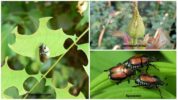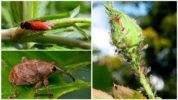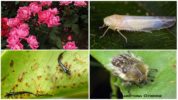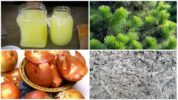- Pests of roses
- Pests of roses
- Pests of roses
- Pests
- Folk pest control
The most beautiful flowers - roses are often attacked by various pests. Insects, their larvae spoil the leaves, buds, lead to diseases, plant death. Description and photos of pests of roses presented in our article. As well as information on how to treat roses, what means to use.
Spider mite
It is active in dry, hot summers, when the temperature stably stays between +29 - +31 ° C. The number of pests increases instantly, as the colony is replenished with new individuals every 14 days. Spider mites suck out the juices of the leaves. Spots, tubercles appear on damaged plates. Leaves curl, darken, fall off.
With significant infection of the flower garden, small beetles eat the whole roses - leaves, stems, buds that are forming, flowers. A characteristic sign of the presence of a pest is the presence of a web. The bugs themselves are miniature in size - up to 2 mm, white, yellow, green, red. If a web and white bugs on a rose are noticed, you need to act immediately.
Bee cutter
Parasitizes in late June, early June. Damages the leaves. A striking sign of wrecking of the leaf cutter is the presence of holes of the correct form on the plate. The flowers remain intact. The insect uses pieces as a building material.
In the immediate vicinity, the bee is building a nest. Construction requires about 1,000 circles of different diameters. Their bee neatly folds, later glues with a special substance. To cut the desired shape, the insect sits on a rose leaf, clings to its jaws, whirls around itself. Picks up material, flies away.
On a note!
The insect does not cause any particular harm to roses, but significantly spoils the presentation. The likelihood of developing fungal diseases is slightly increased.
Bronze
A large beetle of attractive appearance. Body size bronzes comes to 15 mm. The dense shell shimmers in the sun with a copper shine. It is active in June, July, especially likes white, yellow roses. The bug feeds on leaves. The people are also called bronzovik May bug or khrushchem.
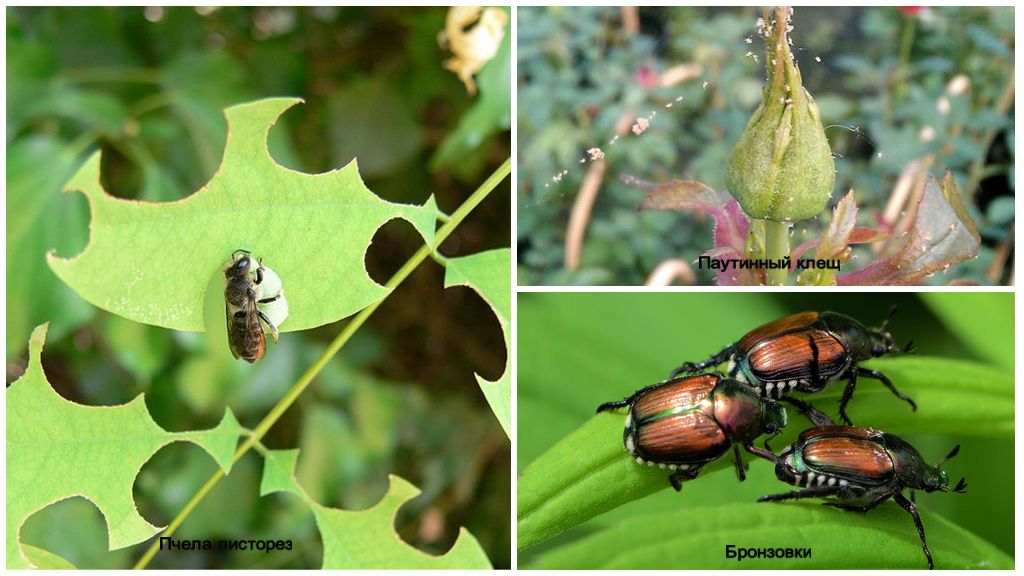
Larvae are large, white caterpillars with long legs, a brown head. They live in the soil, feed on the root system of plants. Larvae lead to weakening of the plant, reduce resistance to disease. If several pests parasitize at once, the plant may die. May bug on roses is not a frequent phenomenon, but dangerous for a flower garden.
Sawfly
There are several types. More often on roses there are green caterpillars with dark dots on the sides. Sawfly eats leaves from the edges, and also penetrates into young shoots, making moves there to a depth of 4 cm. After such vital activity, the shoot withers, and with it leaves, flower buds. In late summer, caterpillars pupate and winter in the soil of the flower garden.
Aphid
The most common pest. Only cold, rainy summers can save flowers. In hot weather aphid multiplies rapidly, about 20 generations are replaced during the season. Small green bugs on roses, no larger than 2 mm, inhabit the underside of the leaf. With a massive infection of the crop, the stems are stuck, penetrate the buds, blossoming flowers.
Green insects feed on juice. There is no significant harm from one individual, but the aphid lives in numerous colonies, so it can destroy a plant in a few weeks. The female lays eggs daily on the leaves of roses. After a couple of days, larvae appear that make moves in the leaves.
On a note!
Symptoms of aphid rose affection are twisted, yellowed, blackened leaves, plant growth retardation, bud dropping. When examining a flower, a colony of beetles is found. Roses can be saved by emergency measures on the part of a person or a sharp cooling.
Pests suck juice, reducing the resistance of roses to disease. Infected fungi penetrate into damaged platinum. Subsequently, this leads to the death of culture.
Weevil
Black beetles on roses with long noses - weevils. Large pests with a massive body - up to 1 cm. The shell is solid, convex, wings are absent. Beetles only crawl, during the day they hide in a secluded place: under lumps of earth, leaves, on neighboring trees. Show activity at night. Leaves of all types of roses, rose hips are eaten.
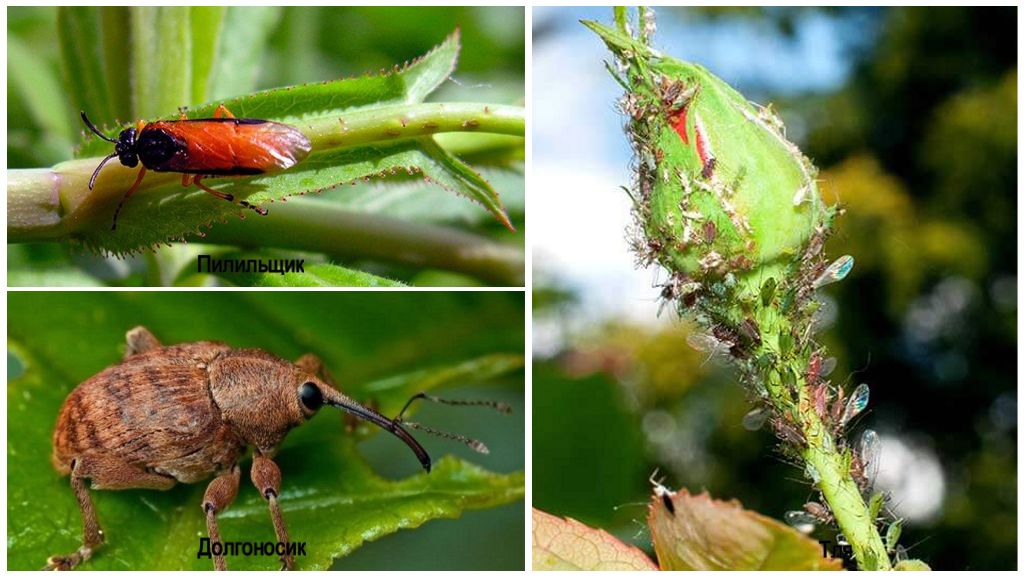
Larvae do more damage to the flowers. Large legless caterpillars of white color. They live in the soil, feed on the roots of roses. With mass infection, quickly lead to the death of the plant. The presence of parasites can be suspected by the weak growth of roses, sluggish flowering.
On a note!
Flowers growing in the shade of trees are especially affected by weevils.
Cicadas
Small bugs of white, yellow color no larger than 3.5 mm. Adults do not eat, larvae are a real pest of rose bushes. Nymphs - bugs 1-2 mm in size. They live on the lower part of the leaves, hide from sunlight. They feed on plant juices. Very mobile, quickly run away, hide.
Dark spots remain at the places of damage, white formations are visible under the leaves - skins after molting of nymphs. Rose bugs suffer from the invasion of bugs, growing in warm, sheltered from the wind places.
Beetle eggs hibernate on shoots at the base of the kidneys. In the spring, with an increase in temperature, they begin to develop. Larvae appear at the moment of budding, so wrecking begins in early May. If you do not take appropriate measures, the rose may not blossom.
Thrips
Small green bugs or light yellow. Body size up to 1 mm. Pests are noticeable due to the large number - they live in colonies. They feed on juices, damage leaves, shoots, buds. Larvae, nymphs, adult bugs parasitize.
Red specks appear on the damaged buds, dark gray spots appear on the leaves. The picture resembles a spider mite damage, but there is no spider web. Roses quickly fade or not bloom at all. Leaves curl, fall off. The plant weakens, gets sick, dies during mass infection.
On a note!
Beetles overwinter in the topsoil under the fallen leaves. In the spring, they feed on weeds initially, then move to roses. Most affected are flowers growing in a dry place - near the walls of the house, on the flower beds on the sunny side.
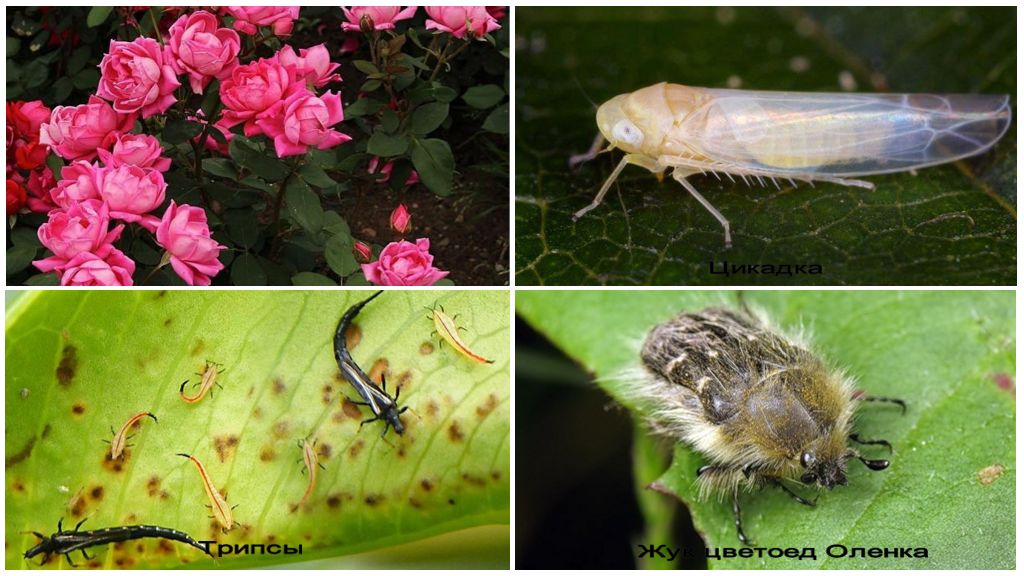
Bug beetle Olenka
Medium insect - up to 12 mm. Color black with shiny tints. The most beautiful bug in our area. It feeds on rose leaves from May to August. It parasitizes itself, therefore it does not cause significant harm. You can get rid of bugs mechanically. Beetles are active during the day in sunny weather, do not bite, they can be easily collected, thrown away from the flowerbed.
Description and treatment of rose diseases
Massive leaf damage disrupts metabolic processes, weakens the immune system, makes the plant susceptible to various diseases.In damaged places, microorganisms accumulate, causing rotting, other pathological processes. All diseases of roses are divided into infectious, non-infectious or fungal. The provocateurs of the latter are insects, their larvae.
On a note!
Due to metabolic disturbances, the amount of useful minerals is reduced. Yellowing, leaf death, weak bud formation results in a lack of manganese, iron, potassium, nitrogen, phosphorus, magnesium, manganese. The treatment is carried out with mineral fertilizers, which restore the necessary balance.
Fungal diseases caused by pests - powdery mildew, leaf spotting, peronosporosis, rust, botritis, bacterial cancer. To save the plant from death, damaged leaves are torn off, burned. The rose is sprayed with fungicides. Effective drugs Ridomil-Gold, Quadris, Skor, Fundazole, Strobi, Profit.
Rose Pest Control
The greatest harm to the flowers is caused by small green bugs of various species - aphids, ticks, thrips, etc. It is possible to deal with rose pests using folk remedies and professional chemicals. The first method is environmentally friendly, but less effective, the second is effective, but beneficial insects can die. The choice of methods, means is an individual decision.
Fighting beetles on roses with chemistry
Processing is carried out early in the morning or in the evening in dry, calm weather. Prepare a solution immediately before use. The concentrate is dissolved in the right amount of water, mixed thoroughly, poured into a garden spray bottle or a spray bottle.
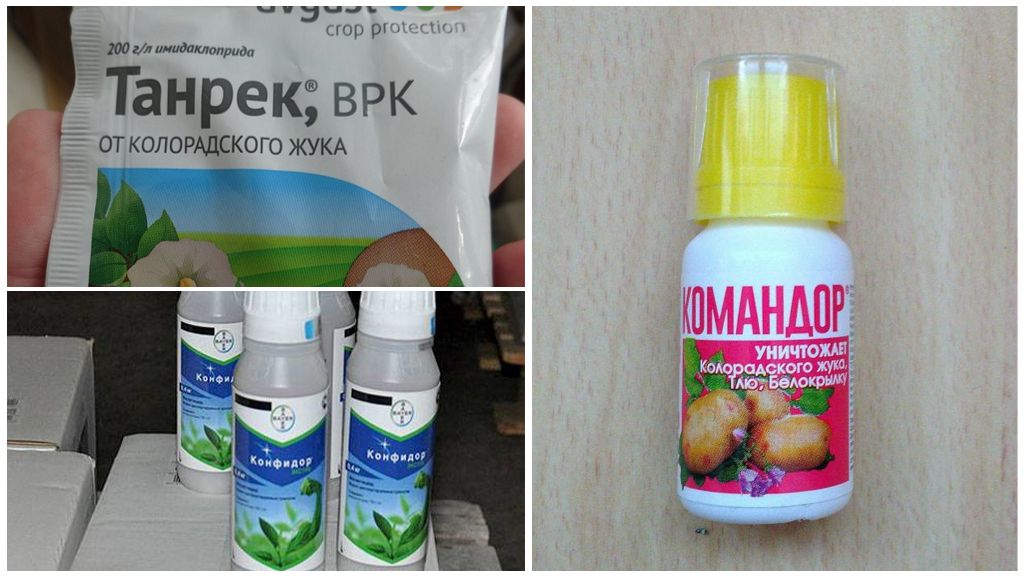
You can get rid of green bugs, other pests in half an hour. The maximum effect lasts 2 hours. After which the drug remains to protect the plant from re-infection for another 20 days. If necessary, repeat the procedure.
The following drugs will help fight green bugs on roses, ticks, and other pests:
On a note!
To combat soil pests, insect larvae they use Pochin, Zemlin.
Chemicals enter the body of pests via the intestinal route. Most of the bugs, caterpillars die during the spraying of crops, the rest - during feeding.
Chemical free processing
What to do if green insects appeared on the rose, there is no desire to use insecticides - use folk remedies. It is necessary to spray flowers twice a week until the complete disappearance of beetles, caterpillars, and other insects.
- Baking soda and salt are mixed in equal proportions. Diluted with water, add household or tar soap. Roses are sprayed from beetles, paying particular attention to the inside of the leaves.
- Ground spices are mixed - black pepper, red pepper, mustard, caraway seeds, coriander. Pour soapy water.
- In equal proportions combine tobacco dust, ash. Add soap, water. Ash burns the legs, abdomen, causing insects to crawl away. If ingested during a meal, it provokes muscle cramps. In 50% of cases for beetles, this ends in death.
- Pour onion husk with water, put on a stove, bring to a boil, cook for 5 minutes. Allow to infuse for at least an hour. Add laundry soap. Used for watering the soil, spraying roses.
- Pests do not tolerate the smell of needles. There are several options. Fresh twigs of pine and spruce are placed on the flowerbed. Essential oil is added to the water, flowers are sprayed. In the latter version, you need to spray the plant every other day.
- If green insects on the buds of roses are aphids, you can get rid of it with milk syrup. Pests do not tolerate sour smell, taste. You do not need to add soap, since the fermented milk product adheres well to the leaves.
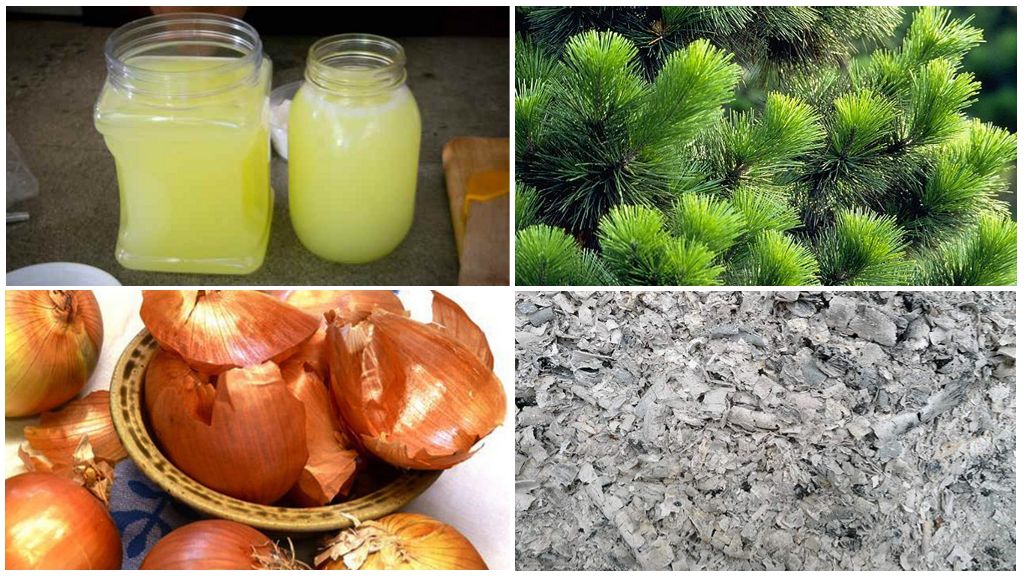
On a note!
To prevent infection by bugs, you need to dig up soil in the flowerbed twice a year, loosen it during the growth of flowers, use fertilizers, water the flowers in dry weather.
Herbal remedies for pests of roses
If you do not want to use chemistry, and folk remedies are ineffective, you can use herbal remedies. Natural insecticides do not act immediately, as toxic substances accumulate in the body of insects. The result is noticeable a week after processing the flowers. Spraying is carried out every 7 days until the beetles completely disappear. It is allowed to combine with fertilizers.
- Fitoverm. The biological product is based on aversectin C. Sold in ampoules. It acts by contact-intestinal route. It takes effect within 24 hours. It protects the plant for up to 15 days, is resistant to sunlight, but decreases its effectiveness in rainy weather.
- Spark bio. Natural product based on a substance with a paralyzing effect. It blocks the transmission of nerve impulses, provokes paralysis, death. The effect occurs within a day. Destroys adults, nymphs, larvae. Effective in hot weather. Retains properties for 2 weeks.
All biological products act similarly. The cost of 15 rubles. per ampoule up to 200 rubles. You can buy the product in a specialty store, retail outlets in the market, and in the department of supermarkets. It is possible to order online.
The most effective method of controlling beetles on roses is the combined one. Physical, agrotechnical, biological, chemical methods of pest control are used.
